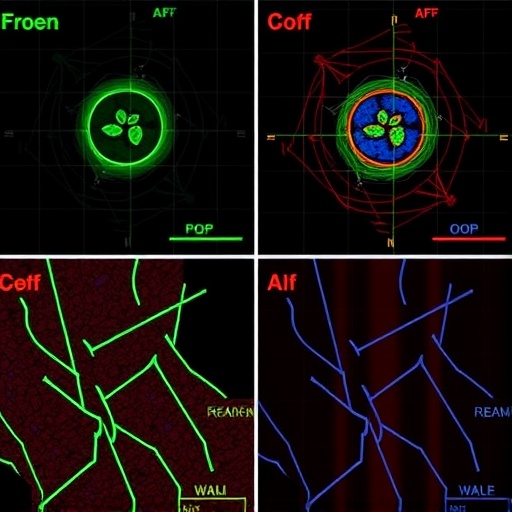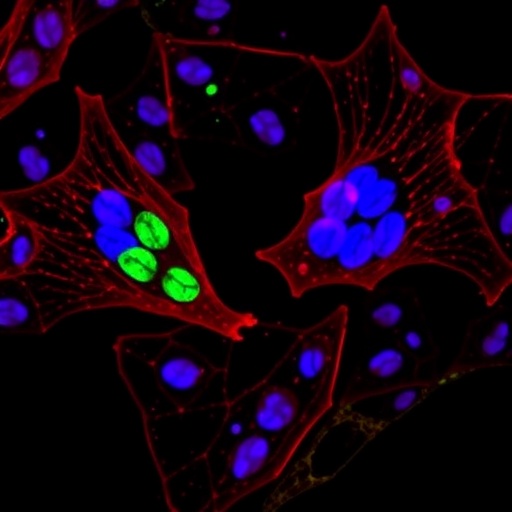In an exciting breakthrough that promises to deepen our understanding of cellular homeostasis and immune system function, a recent study has unveiled a novel pathway that facilitates compartment-specific corpse clearance, fundamentally altering the existing paradigm of cell death management. Researchers have identified the pivotal role of the transcription factor EOR-1, also known as PLZF, in promoting a WAH-1/AIF-dependent mechanism that orchestrates the selective removal of cellular debris within discrete compartments. This pioneering discovery provides unprecedented insight into how organisms maintain tissue integrity and prevent inflammation by precisely targeting dead cells for removal.
Every multicellular organism relies on the efficient and timely clearance of dying cells to prevent tissue damage and inflammatory diseases. The process of corpse clearance, or efferocytosis, has been studied extensively, emphasizing general phagocytosis mechanisms and the roles of various “eat-me” signals expressed by apoptotic cells. However, the new findings highlight a nuanced biological orchestration, where the interplay between EOR-1/PLZF and the apoptotic factor WAH-1 (the ortholog to mammalian Apoptosis-Inducing Factor, AIF) drives compartment-specific clearance, meaning different segments or domains within a cell or tissue are selectively targeted by different molecular machineries.
This novel pathway breaks ground by illuminating how EOR-1/PLZF acts upstream in a signaling cascade that enhances WAH-1/AIF activity. Historically, WAH-1/AIF has been recognized for its role in mitochondrial apoptosis and subsequent nuclear DNA degradation when released into the cytosol. The new study, however, reveals a non-apoptotic facet of this factor, demonstrating its critical role in corpse processing distinct from cell death induction. More intriguingly, the crosstalk between EOR-1/PLZF and WAH-1/AIF finely tunes the clearance of cellular remnants in specific microdomains, preventing indiscriminate phagocytosis that could otherwise compromise healthy neighboring cells.
Unpacking the molecular choreography, the research team employed a combination of genetic, biochemical, and advanced imaging techniques, allowing for visualization of corpse clearance events at an unprecedented resolution. Fluorescent tagging of EOR-1/PLZF and WAH-1/AIF demonstrated their co-localization in targeted compartments, with knockdown and overexpression studies confirming their functional interdependence. This was corroborated by transcriptomic analyses revealing that EOR-1/PLZF modulates the expression of genes involved in mitochondrial dynamics and phagosomal maturation, lending molecular credence to the observed phenomena.
Beyond fundamental biology, the implications of this pathway resonate profoundly within immunology and neurobiology. Faulty clearance mechanisms underpin chronic inflammatory diseases and neurodegenerative disorders such as Alzheimer’s, where persistent cellular debris triggers pathological immune responses. By delineating a pathway that ensures precise corpse clearance, the study opens avenues to therapeutic strategies that could augment or mimic EOR-1/PLZF activity to rectify defective clearance pathways. This could be crucial for diseases where apoptotic cells accumulate or where inflammatory cycles maintain tissue damage.
A particularly striking aspect of the research is its illustration of compartmentalization within corpse clearance, challenging the dogma that phagocytosis operates homogenously. The specialized recruitment of molecular machinery tailored to local subcellular environments allows cells to maintain spatial organization and functional specificity during corpse degradation. This compartmental strategy could mirror other cellular processes where spatial segregation ensures fidelity and minimizes collateral damage, further probing how cellular architecture interlinks with biochemical pathways.
The study also elucidates the evolutionary conservation of this mechanism. EOR-1/PLZF and WAH-1/AIF homologs exist across species boundaries, hinting that compartment-specific corpse clearance might be a universal strategy evolved to optimize tissue homeostasis. This raises exciting prospects for cross-species studies to explore how these proteins have adapted to the complexity of different organismal architectures and immune landscapes, providing a bridge between simple model organisms and human physiology.
At a mechanistic level, the study proposes that EOR-1/PLZF enhances the transcriptional activation of target genes that modulate mitochondrial integrity and phagosome formation, thereby indirectly regulating WAH-1/AIF’s localization and activity. This feed-forward loop underscores a sophisticated regulatory network where transcription factors do not merely initiate responses but also shape the cellular microenvironment to optimize functional outcomes. Through this lens, cell death and corpse clearance emerge as integrated processes rather than sequential, independent events.
The findings further suggest that modulating EOR-1/PLZF or WAH-1/AIF could serve as a strategic target in precision medicine. Drugs or gene therapies designed to enhance their function could accelerate clearance in pathological conditions characterized by defective efferocytosis, whereas inhibitory approaches might be employed to dampen excessive clearance that may contribute to tissue atrophy or autoimmunity. This dual potential unlocks a therapeutic versatility grounded in a profound molecular understanding.
Interestingly, this research aligns with emerging concepts of cellular “compartmental memory” where spatial cues within the cell dictate signaling specificity and downstream responses. By revealing how corpse clearance is influenced by such compartmentalized signaling networks, the study contributes to a broader narrative in cell biology that emphasizes the importance of spatial context, not just molecular identity, in determining cellular fate and function.
The authors’ meticulous approach, combining experimental rigor with conceptual innovation, exemplifies the frontiers of modern cell biology. Leveraging cutting-edge tools like CRISPR-based gene editing, live-cell super-resolution microscopy, and multi-dimensional transcriptomics, their work encapsulates the power of integrative methodologies to solve complex biological puzzles. This study represents a hallmark in understanding how cells maintain harmony amid constant turnover and renewal.
Given the complexity of corpse clearance, future research spurred by this study is poised to explore intricate signaling feedbacks and the role of additional cofactors in the EOR-1/PLZF-WAH-1/AIF axis. Understanding how this pathway interfaces with other cell death modalities—such as necroptosis or pyroptosis—and immune surveillance mechanisms could further enrich the therapeutic landscape. Moreover, unraveling its role in diverse tissues, especially those with high turnover rates or specialized functions like the brain and immune organs, remains an exciting frontier.
Overall, this groundbreaking research redefines the conceptual framework of cell clearance by introducing a compartment-specific mechanism orchestrated by EOR-1/PLZF and WAH-1/AIF. It not only advances fundamental cellular biology but also lays a foundational stone for innovative clinical interventions. As the scientific community assimilates these findings, the promise of precision clearance manipulation heralds a new era in combating diseases rooted in cell death and debris accumulation.
In summary, the discovery of EOR-1/PLZF’s regulatory role in compartment-specific corpse clearance via WAH-1/AIF activity represents a leap forward in our molecular understanding of how cells maintain tissue cleanliness and prevent pathological inflammation. This mechanism’s elegant specificity and evolutionary conservation emphasize its biological importance and translational potential. Future studies will undoubtedly build upon this paradigm, illuminating further intricacies and inspiring novel therapeutic strategies in the fight against degenerative and inflammatory diseases.
Subject of Research: Mechanisms of compartment-specific corpse clearance mediated by EOR-1/PLZF and WAH-1/AIF.
Article Title: EOR-1/PLZF promotes WAH-1/AIF-dependent compartment-specific corpse clearance.
Article References:
Rather, N., Elkhalil, A., Williams, M. et al. EOR-1/PLZF promotes WAH-1/AIF-dependent compartment-specific corpse clearance. Cell Death Discov. (2025). https://doi.org/10.1038/s41420-025-02874-2
Image Credits: AI Generated
DOI: https://doi.org/10.1038/s41420-025-02874-2
Tags: apoptotic cell signalscompartment-specific corpse clearanceefferocytosis processEOR-1 transcription factorimmune system functioninflammatory disease preventionmolecular orchestration in cell deathnovel pathways in apoptosisPLZF and cellular homeostasistargeted cell cleanuptissue integrity maintenanceWAH-1/AIF mechanism





